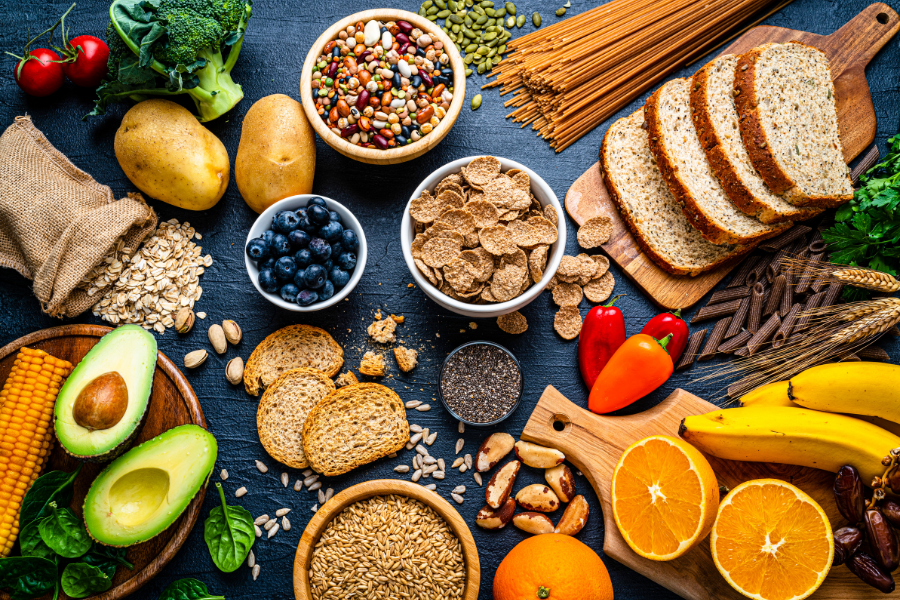.png?lang=en-CA)
Fibre, a mostly indigestible form of carbohydrate, is an important yet often overlooked part of our diet. Unlike sugars or starches, fibre passes through the digestive system relatively intact, helping to promote healthy gut bacteria and provide many other health benefits. It offers support for heart health, blood sugar levels, bowel regularity and more, making it a game changer for senior health and longevity.
The Power of Fibre: A Key to Senior Health
Fibre is found in a wide variety of foods such as fruits, vegetables, beans, whole grains, nuts, seeds, and legumes, so it may be surprising to learn that most Canadian seniors consume only about half of their recommended daily fibre. While fibre doesn't get absorbed like other nutrients or provide calories or energy, it plays a critical role in digestive and overall health, helping to move food through the digestive tract and keep bowel movements regular. It can also keep you feeling fuller longer.In addition to supporting normal bowel function, fibre is known for its ability to help lower LDL cholesterol (think L for “lousy”), regulate blood sugar, lessen inflammation, and even reduce the risk of heart disease. Getting adequate fibre may also lower the risk of other diseases, such as colon and stomach cancer. Adding fibre to your diet isn’t just about preventing constipation – it’s a holistic way to support long-term health.
.png?lang=en-CA)
The Two Types of Fibre and Their Benefits
Fibre comes in two main types, each serving a unique purpose:• Insoluble Fibre: Often called the “pot scrubber” of the colon, it helps keep you regular by literally scrubbing your colon as it passes through. Some examples of insoluble fibre include the skins of apples, peaches and other skinned fruits, the seeds in fruit and vegetables such as tomatoes and strawberries, the stringy stuff on celery and the outer shells of beans, whole grains and bran. It literally helps scrub and clean out the walls of the large intestine and is then eliminated in your stool.
• Soluble Fibre: This type of fibre “bulks up” stools and helps lower cholesterol and control blood glucose. Whereas insoluble fibre occurs most often on the peels of foods, soluble fibre is found in the flesh of fruits, in vegetables like carrots and in plants like oats, barley, the insides of legumes like beans and lentils. When you make apple sauce or jam, it is the soluble fibre (pectin) in the fruit that causes it to gel. Soluble fibre works the same way in “gelling up” stool.
Both types of fibre are crucial for maintaining overall health for seniors and should be incorporated into your regular diet.
.png?lang=en-CA)
How Much Fibre Do Seniors Need?
The recommended daily intake of fibre typically varies based on age and gender. For seniors, the North American recommended amount is:• 30 grams per day for men aged 51+
• 21 grams per day for women aged 51+
While this may seem like a lot, it's entirely achievable with the right foods. Including a variety of fibre-rich foods in your diet—such as whole grains, legumes, fruits, and vegetables—can make it easier to meet these recommendations.

Tips for Incorporating More Fibre into Your Diet
• Start Slow: If you’re not used to consuming a lot of fibre, it’s important to increase your fibre intake gradually to give your digestive system time to adjust and avoid gas and bloating.• Incorporate Physical Activity: Adding some physical activity to your daily routine can help support digestion and also prevent discomfort from bloating or gas.
• Drink Water: Fibre acts like a sponge, absorbing water, so make sure to drink plenty of water throughout the day to stay hydrated.
• Choose Whole Foods: Opt for whole grains, legumes, fruits, and vegetables in your diet to maximize fibre intake. Foods particularly high in fibre include apples, berries, pears, oranges, bananas, broccoli, asparagus, spinach, sweet potato, carrots, avocado, prunes, lentils, beans, chia seeds, nuts, steel cut oats, certain cereals, and whole grain pastas and breads.
It’s also important to note that juice, despite common belief, often does not provide fibre even if it contains pulp. So, instead of drinking juice, enjoy whole fruits to get the full benefits of fibre!
.png?lang=en-CA)
Conclusion: The Magic of Fibre for Seniors
Fibre may seem straightforward, but its impact on health cannot be understated. For seniors, it supports digestion, heart health, and blood sugar management, and can even reduce the risk of certain diseases. By making small changes – like choosing fibre-rich foods and drinking plenty of water – you will experience the wellness wonder fibre can bring to your overall health!Heart to Home Meals offers a High Fibre diet code - providing a selection of meals that contain more fibre per serving and make it easier to get your recommended daily intake! You can browse all of our high fibre meals by clicking right here!
.png?lang=en-CA)


